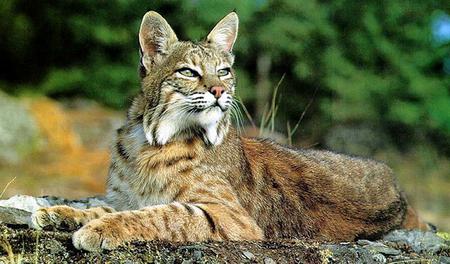
Bobcats are very secretive, solitary, and seldom seen by people in the wild. Bobcats are active during the day, but prefer to be crepuscular or nocturnal in habitats where they exists. Bobcats tend to travel well-worn animal trails, logging roads, and other paths. They use their acute vision and hearing for locating enemies and prey. Bobcats do not form lasting pair bonds. Mating can occur between most adult animals. In Wyoming, female bobcats reach sexual maturity within their first year but males are not sexually mature until their second year. Nationwide, breeding can occur from January to June. In Wyoming, breeding typically begins in February and the first estrus cycle in mid- March.
The gestation period in bobcats ranges from 50 to 70 days, averaging 62 days. Nationwide, young are born from March to July, with litters as late as October. The breeding season may be affected by latitude, altitude, and longitude, as well as by characteristics of each bobcat population. In Wyoming, births peak mid-May to mid-June and can occur as late as August or September. These late litters may be from recycling or late-cycling females, probably yearlings. In Utah, births may peak in April or May. In Arkansas, births may peak as early as March. Bobcats weigh about 2/3 pound at birth. Litters contain from 2 to 4 kittens. Kittens nurse for about 60 days and may accompany their mother through their first winter.
Although young bobcats grow very quickly Fig. 2 Range of the bobcat in North America. During their first 6 months, males may not be fully grown until 1 1/2 years and females until 2 years of age. Bobcats may live for at least 12 years in the wild. Bobcats reach densities of about 1 per 1/4 square mile on some of the Gulf Coast islands of the southeastern United States.
Densities vary from about 1 per 1/2 square mile in the coastal plains to about 1 cat per 4 square miles in portions of the Appalachian foothills. Mid-Atlantic and midwestern states usually have scarce populations of bobcats. The social organization and home range of bobcats can vary with climate, habitat type, availability of food, and predators. Bobcats are typically territorial and will maintain the same territories throughout their lives. One study showed home ranges in south Texas to be as small as 5/8 square mile.
Another study showed that individual bobcats in southeastern Idaho maintain home ranges from 2.5 square miles to 42.5 square miles during a year. Females and yearlings with newly established territories tend to have smaller and more exclusive ranges than males. Females also tend to use all parts of their range more intensively than adult males.
Bobcats commonly move 1 to 4 miles each day. One study found that bobcats in Wyoming moved from 3 to 7.5 miles each day. Transient animals can move much greater distances; for example, a juvenile in one study moved 99 miles. Adult bobcats are usually found separately except during the breeding season. Kittens may be seen with their mothers in late summer through winter. An Idaho study found adult bobcats and kittens in den sites during periods of extreme cold and snow. Females with kittens less than 4 months old generally avoid adult males because they kill kittens.
In Canada and the western United States, bobcat population levels tend to follow prey densities. Some biologists believe that coyote predation restricts bobcat numbers. Unfortunately, not enough is known about the relative importance of factors such as litter size, kitten survival, adult sex ratios, and survival rates to predict changes in local bobcat populations. Also, relatively low densities and variable trapping success hinder researchers from easily predicting changes in populations.
Since the late 1970s, state game agencies have been tagging bobcat pelts harvested in their states. Information from these pelts is being used to estimate bobcat population trends and factors that contribute to those changes.
MEOW TO BOBCATS!!!!!!!!!!!